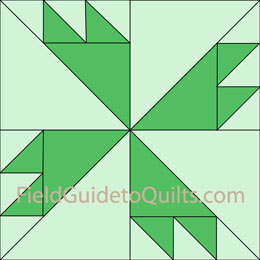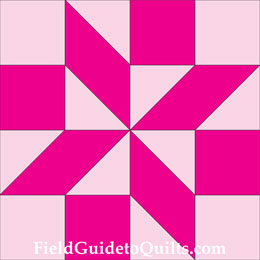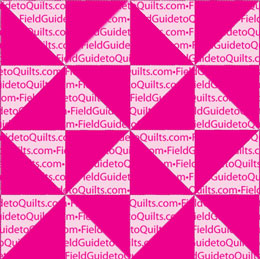On this page we cover three shapes that we call Windmills  , Turnstiles , Turnstiles  , or Whirlwinds , or Whirlwinds  after blocks of those names. after blocks of those names.
You'll notice that a turnstile is a windmill set on point. In several blocks, below, they're combined.
 Turnstile LAC #519 Windmill  Mosaic No. 9  Electric Fan No. 1  Old Windmill  Windmill
LAC #127 Dutch Windmill  Rosebud  The Flying X Quilt
Coming soon:
 Rhubarb Twist  Blocks & Pinwheels  Shooting Star  Clay's Choice |
|
Turnstile
   
   
   
   
Turnstile
 TurnstileFarm & Fireside TurnstileFarm & Fireside
1904
Barbara Brackman found Turnstile published, nameless, in a 1904 Farm & Fireside magazine, and the Ladies Art Company included it as Turnstile 24 years later in its 1928 catalog (#519).
Once you're familiar with the design, you'll see it in the center of dozens of blocks, sometimes hidden by the quilter's choice of colors. Take a look at Big Dipper and Yankee Puzzle: 
The block is simple to piece and easy to find on the web; our Make It! link goes to just one of many sets of instructions. |
|
Windmill
 Windmill/Mosaic No. 9 Windmill/Mosaic No. 9 WindmillOhio Farmer WindmillOhio Farmer
1898
 The Broken Wheel/Corn Design/Crow's Foot/Fan Mill/Fly/Four Leaf Clover/Kathy's Ramble/Mill Wheel/Sugar Bowl/Old Crow/Water Mill/Water Wheel/Windmills The Broken Wheel/Corn Design/Crow's Foot/Fan Mill/Fly/Four Leaf Clover/Kathy's Ramble/Mill Wheel/Sugar Bowl/Old Crow/Water Mill/Water Wheel/Windmills
A block this basic is bound to have a lot of names, and it does. Barbara Brackman credits Ohio Farmer for the earliest cite: Windmill, 1898.
Most of the other names came from the books by Ruth Finley (1929) and Carrie Hall (1935). The Make It! icon links to designer Jinny Beyer's site; she calls it Crow's Foot.
Mosaic No. 9
 Mosaic No. 9
LAC, #337 Mosaic No. 9
LAC, #337
1898
The Ladies Art Company's #337 is simply four Windmill blocks put together. All the other names above are from the Chicago Tribune (1934-1937) except Pinwheel (1931), which is from a quilt-pattern booklet. A whole quilt in two colors looks like our mockup above.
The block would make a terrific scrap quilt. The LAC hoped that quilters would buy patterns (15 cents) or diagrams (5 cents). Or customers could order ready-made blocks, too. Mosaic No. 9 blocks, in 1928, went for 40 cents each or $4.50 a dozen, buyer's choice of colors. |
|
| |
Old Windmill
   
   
   
   
Old Windmill
 Old Windmill
Progressive Farmer Old Windmill
Progressive Farmer Windmill Windmill
For the name Old Windmill, Yvonne Khin cites Progressive Farmer, a magazine that dates back to 1886 and is still being published. Nancy Cabot included it as Windmill in her Chicago Tribune column in 1933. In 1935, quilt researcher Carrie Hall called the block Windmill (Havig).
Nowadays, the block also goes by Turnstile, which makes sense, because there's a turnstile in the middle of the block. We haven't found an original source for that name. It's up to you whether you see a carpet of turnstile shapes or a carpet of windmills in the mockup at right. |
| |
|
Electric Fan
   
   
   
   
Electric Fan, No. 1
 Electric Fan Electric Fan, #1
Stone
1906  Electric Fan is from Clara Stone's Practical Needlework (1906). Electric Fan is from Clara Stone's Practical Needlework (1906).
The block has a windmill and two turnstiles. One turnstile is in bright pink; the other is in maroon, facing the opposite direction.
Color placement was as we've shown it at left.
To see Stone's Electric Fan #2, click here: 
|
|
Windmill
 Windmill Windmill
LAC, #127
1895  The LAC's block #127, Windmill is really a variation of a Turnstile block. It is not often used nowadays, so our Make It! icon links to a copy of an actual page from the Ladies Art Company instruction sheet. The LAC's block #127, Windmill is really a variation of a Turnstile block. It is not often used nowadays, so our Make It! icon links to a copy of an actual page from the Ladies Art Company instruction sheet.
TheQuiltIndex.org says that the original publication was in 1895.
On this site, we assume that all LAC blocks appeared, as if dropped from the sky, with its first full catalog of blocks in 1898. That isn't quite true, because the first 400 blocks appeared in various publications, one by one, or in block lists, for several years before that.
We've made an exception on Windmill for the sake of good will, harmony, and respect for our even-more-quilt-poxied colleagues.
| |
Humming Bird/Rosebud
   
   
   
   
Humming Bird/Rosebud
 Humming Bird/ Humming Bird/
Rosebud
Stone,
1906 Rosebud/Crow's Foot/Bright Star/Budding Roses/Rose Bud/Maple Leaf Rosebud/Crow's Foot/Bright Star/Budding Roses/Rose Bud/Maple Leaf
Although it often goes by Rosebud, Clara Stone's Practical Needlework introduced this block as Humming Bird in 1906 (#74).
The other names followed: Rosebud (LAC #517, 1928); Crow's Foot (Old Fashioned Quilts, ca. 1931), Bright Star (Nancy Cabot, 1934), Budding Roses (Nancy Page, 1939), Rose Bud (Hall, 1935), and Maple Leaf (Nancy Cabot, 1936).
|
The Flying X Quilt
 The Flying X Quilt
KCS,
1931 The Flying X Quilt
KCS,
1931 Double Quartet, The X Quartette Double Quartet, The X Quartette
The contributor who sent this block to the Kansas City Star, which published it as The X Quartette in 1939, may not have realized that her block had already been published twice—in a 1932 Grandmother Clark booklet as Double Quartet, and once in the Star, the year before, as the Flying X Quilt. A different Star reader had sent it in.
The third name combines the first two, so someone at the Star must have realized it was a recent reprint. Why didn't they replace the block with something new? Was it too close to deadline? Why "double?" Why "X?"
"Double Quartet" makes sense if you see the star as a set of bowtie blocks wheeling within the square. If you see bowties as X shapes, the other names make sense too. |
 Windmills, Turnstiles, Whirlwinds
Windmills, Turnstiles, Whirlwinds Windmills, Turnstiles, Whirlwinds
Windmills, Turnstiles, Whirlwinds